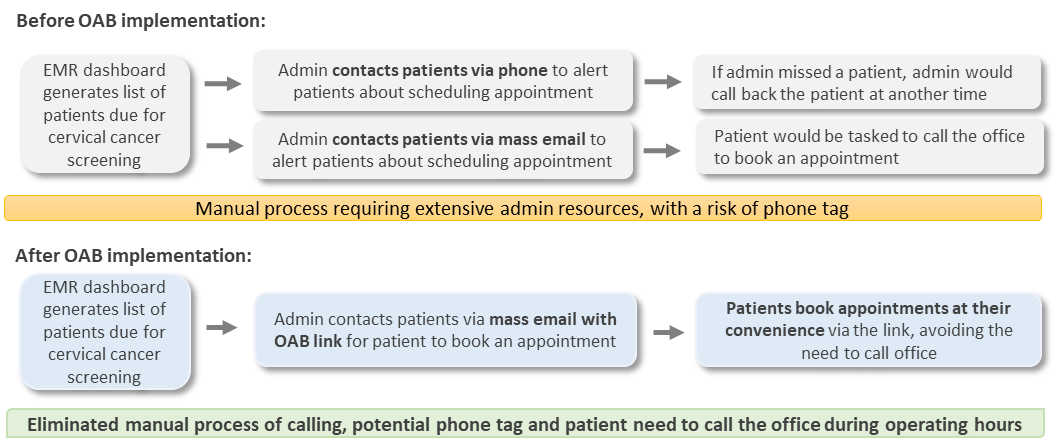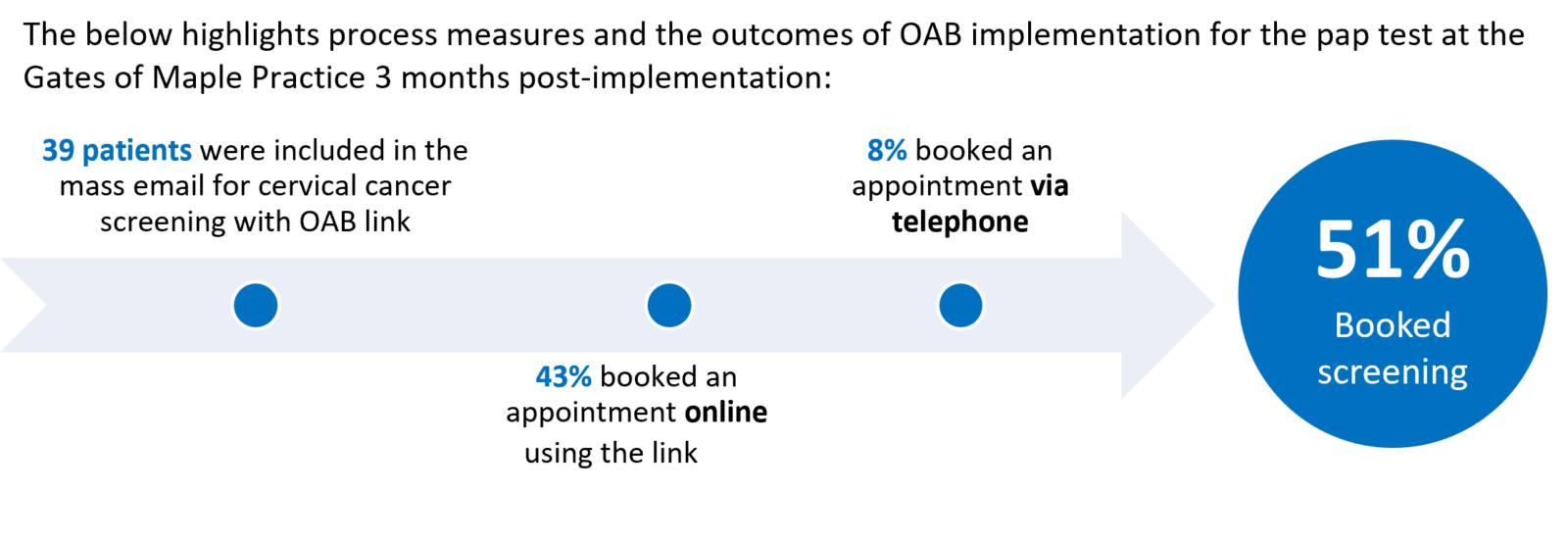A case study on a clinic’s experience using Online Appointment Booking for cervical cancer appointments and reminders for patients
Preventative care is a pillar of primary health care. Since the 1980s, there has been a dramatic decline in the rate at which people who have a cervix in Ontario (women, transgender, and nonbinary people) have developed and died from cervical cancer.1 This can be almost entirely attributed to the implementation of regular preventative pap tests through primary care clinics.1,2 The current Ontario guidelines suggest screening for cervical cancer in sexually active individuals with a cervix between the ages of 25 and 69 every three years.3 Although the Ontario screening program provides letters to eligible people due for a pap test, participation in cervical screening remains moderate across Ontario.1,4 More than one-fifth of Ontarians who are eligible for breast, cervical and colorectal cancer screenings were found to be overdue for screening by five or more years, despite universal healthcare coverage and the presence of an organized cancer screening program.5 Additionally, 55% of individuals diagnosed with cervical cancer had not had a pap test in more than 5 years prior to their diagnosis. Cervical cancer remains the third most common cancer among individuals with a cervix in Ontario.2 Clearly, additional recruitment strategies are required to support an increase in cervical cancer screenings.
Key takeaways
Online Appointment Booking enhances clinical efficiencies and is showing potential to increase uptake of cervical cancer screening appointments for patients.
Gates of Maple Family Practice implemented Online Appointment Booking (OAB) to streamline processes such as cervical cancer screening booking for the clinic and patients. The clinic aimed to make the process less labour intensive for administrative staff to notify patients due for a pap test appointment, as well as make it easier and more convenient for patients to book their own appointments. Figure 1 below illustrates clinic workflows for booking cervical cancer screenings before and after OAB implementation.
Figure 1: Gates of Maple Family Practice Cervical Cancer Screening Workflow Before and After OAB Implementation

The below highlights process measures and the outcomes of OAB implementation for the pap test at the Gates of Maple Practice 3 months post-implementation:

The above outcomes are promising considering a previous study in Ontario examining the impact of invitation and reminder letters on cervical cancer screening had found that only 14% of women that received reminder letters had a Pap test within 9 months of the invitation letter.6 OAB has the potential of increasing the likelihood of patients adhering to cervical cancer screening rates in Ontario by making it easy and efficient to book appointments.
Gates of Maple Family Practice implemented OAB in various stages. Prior to rolling out OAB, staff had some hesitation partly due to giving up some control with triaging patients as part of the process. Thus, OAB was only open for pap smear screening appointments initially.
After several weeks of testing, which gave clinic staff the opportunity to familiarize themselves with the new technology, other appointment types, such as diabetes follow-up and shingles injections, were available for patients to book online.
Figure 2. Identified benefits of OAB for Pap Smear Appointments from the perspective of Gates of Maple Family Practice
Less labour-intensive for admins to send out mass emails than to call individual patients
Patients able to easily book pap smear appointments at their convenience, allowing some patients to choose timing based on their menstrual cycle
Mass email communication avoids phone tag with patient
OAB link to schedule appointments makes uptake of cervical cancer screening more likely
- Cancer Care Ontario. (n.d.). Ontario Cervical Screening Program. Retrieved August 3rd, 2022
- Jackson, R., Wang, L., Jembere, N., Murphy, J., & Kupets, R. (2019). Why Do Women Get Cervical Cancer in an Organized Screening Program in Canada? Journal of Lower Genital Tract Disease, 1-6.
- Li Wang, J. N., & Upshur, R. E. (2009). Determining use of preventive health care in Ontario. Canadian Family Physicians Le Medecin de Famille Canadien, 178-179.
- Lofter, A. K., Kopp, A., Vahabi, M., & Glazier, R. (2019). Understanding those overdue for cancer screening by five years or more: A retrospective cohort study in Ontario, Canada. Preventative Medicine.
- Ministry of Health. (2021, October 21). Cervical Cancer Testing and Prevention. Retrieved August 3, 2022
- Tavasoli, Simon M., et al. (2016). Impact of invitation and reminder letters on cervical cancer screening participation rates in an organized screening program. Gynecologic Oncology.
Interested in learning more?
Interested in partnering with us or learning more about
what we can offer you? Please reach out here.
Get the latest resources and insights
-

eReferral user satisfaction with the Ocean Portal
Ocean eReferral users who access the solution through the online portal are satisfied with the…
-

Ocean to OTN Integration
To further increase adoption and utilization of the Ontario Health (OH) eConsult Service, Ocean eReferral…
-

Plain Language Description and Safeguards of the eReferral Service
eReferral refers to the automation of one or more activities involved in initiating, negotiating and closing the referral…
-

Webinar on leveraging AI scribes for your ideal practice (part 1)
Sharing some tips, tricks, and key takeaways from our Ideal Primary Care Practice Model webinar,…